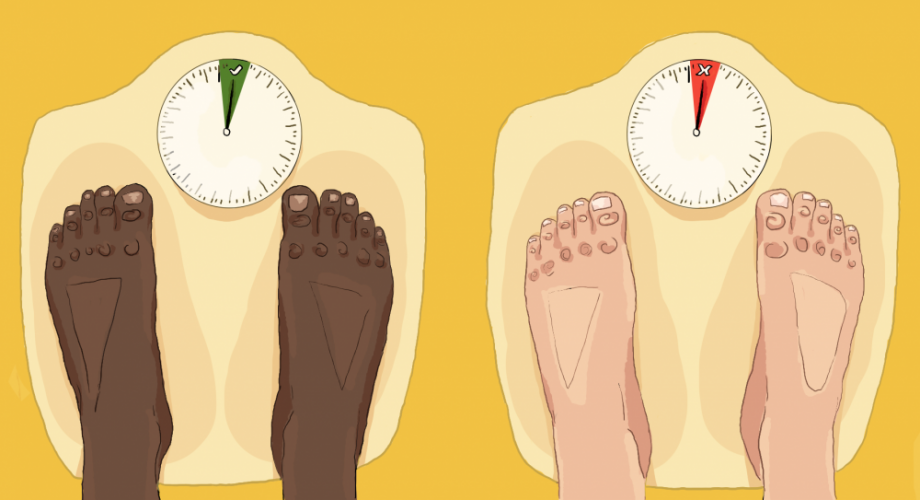In the Blog
Eating Disorders are not just a White Feminist Issue

Illustration by Saul Freedman-Lawson.
I developed an eating disorder at 18 years old. This was a time in my life when I was grappling with my identity, having just graduated high school, parted ways with many close friends, and unsure of what my future held.
I attempted to assert control over my life by conforming to idealistic, and often unattainable, societal beauty norms marked by thinness. These efforts became the catalyst for my eating disorder and were heightened by predispositions and comorbid mental illnesses, such as anxiety and depression.
As a person of colour, I began wondering how my lived experiences had played a role in the development of my eating disorder. I had grown up in an Indian family with very Western parents and went to schools that were predominantly occupied by White students. I had always somewhat struggled with fitting into the norms of Western culture but the biggest difficulty I faced had to do with my physical appearance (e.g., skin colour, facial features, etc.).
Achieving the Western ideal that has constantly praised thin, White women has thus, always been slightly out of reach for me. My eating disorder, which started off as an innocent attempt to lose weight, was, in part, motivated by these norms.
If we begin applying Kimberlé Crenshaw’s notion of intersectionality, which refers to the interlocking forms of oppression that a given person may be subjected to, this concept may become clearer.
The experiences of a young girl of colour, for instance, may differentially impact the likelihood of her developing disordered eating behaviours and/or engaging in body modification practices. To elaborate, Western feminine beauty norms, as ubiquitously portrayed in the media, make the process of conforming that much more difficult for girls of colour. We can see this reflected in stats that indicate teenagers of colour are more likely to engage in bulimic behaviours (e.g., binging and purging), in comparison to their White peers.
Other stressors that people of colour may be more vulnerable to, such as body-based harassment (e.g., teasing), racism and poverty may also heighten these behaviours.
Because eating disorders are stereotyped as an illness that solely affects young, White, thin girls from middle-to-high socioeconomic backgrounds, those that present differently often get dismissed by physicians, may fear coming forward because they do not subscribe to the dominant norms, or completely deny that they have an eating disorder altogether because of internalized socio-cultural discourses that create a narrow definition of what eating disorders look like and who they affect.
To reinforce this concept, the National Eating Disorder Association has provided research-based evidence on their website that emphatically supports how myths regarding who is affected by eating disorders disadvantages people of colour.
One study evidenced that when presented with eating disorder cases among Black, Hispanic and White women, clinicians only identified 17% of Black patients eating behaviours as problematic as opposed to 44% of White and 41% of Hispanic patients.
For immigrants and refugees, the process of acculturation presents even greater difficulties in terms of achieving Western body ideals. Studies have indicated that conflicting cultural views in relation to food and weight have resulted in increases in weight preoccupation and disordered eating behaviours among newcomers, yet our societies continued focus tends to remain on affluent, young White girls. Note: this is not to say that those living outside of the West do not struggle with eating disorders, but is simply bringing attention to the power of socio-cultural forces in the West and how they factor into eating disorder discourses.
As a person of colour, I went through many stages during the process of recovering from my eating disorder, the first being complete denial. I thought I knew what girls with eating disorders looked like and I had convinced myself I was not that. From my experiences, I had not seen anyone portrayed in the media with an eating disorder who was not White and emaciated to the point of near-death.
However, entering treatment opened my eyes to the diverse range of folks who struggle with disordered eating. I was in treatment with folks who represented a wide range of sizes and shapes, who were not only White, but were Black, Hispanic, Indigenous, East Indian, and more.
The treatment program I attended was unique in that it was covered by healthcare (making it more accessible) and actively worked to address the myths that typically prevent diverse folks from receiving appropriate help for their eating disorder. On the flip side, programs such as these also typically have a large waitlist, low funding and, in turn, lower capacity to operate. These are issues that still need unpacking in countries such as Canada.
My experiences have helped me to realize that eating disorders do not discriminate, much like media and socio-cultural norms suggest they do. Eating disorders are a feminist issue that must include diverse perspectives and insight from a broad range of folks from the community, not only those who identify as the status quo eating disorder patient. They are life-threatening mental illnesses and everyone and everyBODY deserves to receive treatment without being denied. In order for that to happen, we must work to change the narrative and begin accounting for the experiences of women of colour.
Anita Khakh
Anita is a master’s student at the University of Alberta studying Educational Policy Studies and specializing in Social Justice and International Studies. She was born and raised in Edmonton, Alberta and describes herself as an intersectional feminist, interested in better understanding how students construct their body image in school environments.
Twitter: @AnitaKaurK Instagram: @anitak.k



